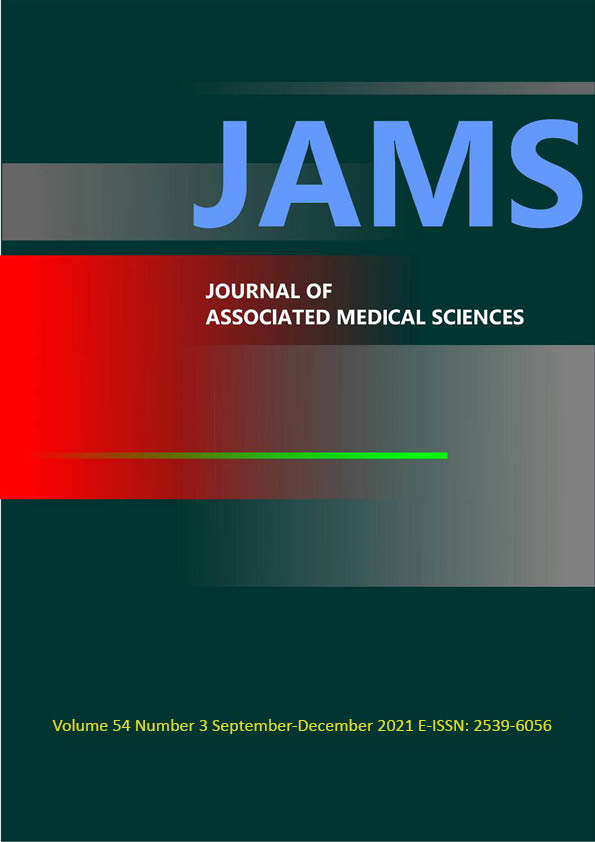Activities of daily living performance in stroke survivors receiving services from the trained village health volunteers at Doi Lor Community Rehabilitation Center, Doi Lor District, Chiang Mai Province, Thailand
Main Article Content
Abstract
Background: Stroke is a major health problem in Thailand. The majority of stroke survivors suffer a sequela of the disease such as muscle weakness, sensory deficits, visual problems, and perceptual and cognitive function disorders. All of these lead to poor performance in activities of daily living for those survivors. Community-based rehabilitation is considered a potential approach that promotes functional performance in stroke individuals.
Objectives: The purpose of the current study was to investigate the effectiveness of rehabilitation services provided by trained village health volunteers (VHVs) in activities of daily living performance for stroke patients.
Materials and methods: This study was a one-group pre-test and post-test research design. Eleven stroke subjects were recruited by purposive sampling from Doi Lor Community Rehabilitation Center in Chiang Mai Province. Their activities of daily living performance were compared before and after the treatment program. The instrument used was The Activities of Daily Living Assessment Tool. Statistics used were descriptive and included the Wilcoxon Signed Ranks Test.
Results: Results demonstrated that the basic activities of daily living performance in stroke participants increased significantly from pre-intervention to post-test (z=-2.223, p<0.05). Also, scores in the instrumental activities of daily living of these individuals increased from pre-test to post-test significantly (z=-2.805, p<0.05).
Conclusion: It was indicated that Doi Lor Community Rehabilitation Center run by trained VHVs could provide effective improvement in activities of daily living performance in stroke clients.
Article Details

This work is licensed under a Creative Commons Attribution-NonCommercial-NoDerivatives 4.0 International License.
Personal views expressed by the contributors in their articles are not necessarily those of the Journal of Associated Medical Sciences, Faculty of Associated Medical Sciences, Chiang Mai University.
References
Suwanwela NC. Stroke Epidemiology in Thailand. Journal of Stroke. 2014; 16(1): 1-7.
Srivanichakorn S. Morbidity and mortality situation of non-communicable diseases (diabetes type 2 and cardiovascular diseases) in Thailand during 2010-2014. Disease Control Journal. 2017; 43(4): 379-90.
Number and mortality rate of non-communicable diseases Year 2016-2018 (Hypertension, diabetes, ischemic heart disease, cerebrovascular disease, bronchitis and chronic obstructive pulmonary disease) [Internet]. 2021, Mar [cited Mar 22, 2021]. Available from: http://www.thaincd.com/2016/mission/documents-detail.php?id=13486&tid=32&gid=1-020.
Division of Policy and Strategy Office of the Permanent Secretary Ministry of Public Health. Numbers and motality rate in non-communicable diseases and trauma in year 2015. Bangkok: Division of Policy and Strategy, Office of the Permanent Secretary Ministry of Public Health; 2016.
Bunyamark T. Occupational therapy in stroke. In: Chinchai P, Bunyamark T, editors. The occupational therapy for persons with neurological conditions. 4th Ed. Chiang Mai: Siam Pimnana Company Limited; 2017.
Gillen G. Cerebrovascular accident/stroke. In: Pendleton HM, Schultz-Krohn W, editors. Pedretti's Occupational Therapy: Practice Skills for Physical Dysfunction. 7th Ed. St. Louis, MO: Elsevier Mosby; 2013. p. 844-80.
Gillen G. Cerebrovascular accident (Stroke). In: Pendleton HM, Schultz-Krohn W, editors. Occupational Therapy: Practice Skills for Physical Dysfunction 8th ed. St. Louis, MO: ELSEVIER; 2018. p. 809-40.
Chinchai P, Marquis R, Passmore A. Functional performance, depression, anxiety, and stress in people with spinal cord injuries in Thailand: A transition from hospital to home. Asia Pacific Disabil Rehabil J, 2003; 14(1): 30-40.
Pakdee P, Chinchai P. The influence of home visit program on functional abilities and quality of life in persons with disabilities resulting from stroke. Bull Chiang Mai Assoc Med Sci, 2016; 49(2): 276-85.
Hung K, G., Fong K. Effects of telerehabilitation in occupational therapy practice: A systematic review. Hong Kong J Occup Ther, 2019; 32(1): 3-21.
Empowerment of Persons with Disabilities Act, B.E. 2550 (2007, September 27).
Office of the Chief Administrator of the Subdistrict Administrative Organization. History and general information of the Doi Lor Subdistrict Administrative Organization 2021 [cited 2020. Available from: http://www.doilor.org/about.php?id=1.
Apichai S, Chinchai P, Dhippayom JP, Munkhetvit P. A new assessment of activities of daily living for Thai stroke patients. CMU J Nat Sci. 2020; 19(2): 176-90.
Chuengsatiansup K, Suksuth P. Health volunteers in the context of change: potential and developmental strategies. J Health Systems Res. 2007; 1(3-4): 268-79.
Bhutta ZA, Lassi ZS, Pariyo G, Huicho L. Global experience of community health workers for delivery of health related millennium development goals: A systematic review, country case studies, and recommendations for integration into national health systems. Global Health Workforce Alliance, World Health Organization. 2010; 1: 249-61.
Administrator of Human Resource Development Office. Village Health Volunteers are Hard-to-Imitate: Worker Ants in Thailand’s Healthcare System [updated 23 April 2020; cited 2563 23 April]. Available from: https://hrdo.org/en/village-health-volunteers-are-hard-to-imitate-worker-ants-in-thailands-healthcare-system/.
Kauffman KS, Myers DH. The changing role of village health volunteers in northeast Thailand: An ethnographic field study. Int J Nurs Stud. 1997; 34 (4): 249-55.
Dans A, Ng N, Varghese C, Tai E, Firestone R, Bonita R. The rise of chronic non-communicable diseases in southeast Asia: Time for action. The Lancet. 2011; 377(9766): 680-9.
Kowitt SD, Emmerling D, Fisher EB, Tanasukarn C. Community health workers as agents of health promotion: Analyzing Thailand's village health volunteer program. J Community Health. 2015; 40(4): 780-8.
Doilo Subdistrict Administrative Organization. Annual Report 2020. Chiang Mai: Doilo Subdistrict Administrative Organization; 2020.
Chinchai P, Jindakham N, Apichai S. Functional abilities of stroke survivors receiving services at community rehabilitation center. J Assoc Med Sci. 2017; 50(3): 336-46.
Park YJ, Lee CY. Effects of community-based rehabilitation program on activities of daily living and cognition in elderly chronic stroke survivors. J Phys Ther Sci. 2016; 28: 3264-6.
Ru X, Dai H, Jiang B, Li N, Zhao X, Hong Z, et al. Community-based rehabilitation to improve stroke survivors’ rehabilitation participation and functional recovery. Am J Phys Med Rehabil. 2017; 96(7): e123-e9.
Chinchai P, Sirisatayawong P, Jindakum N. Community integration and quality of life: stroke survivors as recipients of rehabilitation by village health volunteers (VHVs) in Thailand. Occup Ther in Health Care. 2020; 34(3): 277-90.


